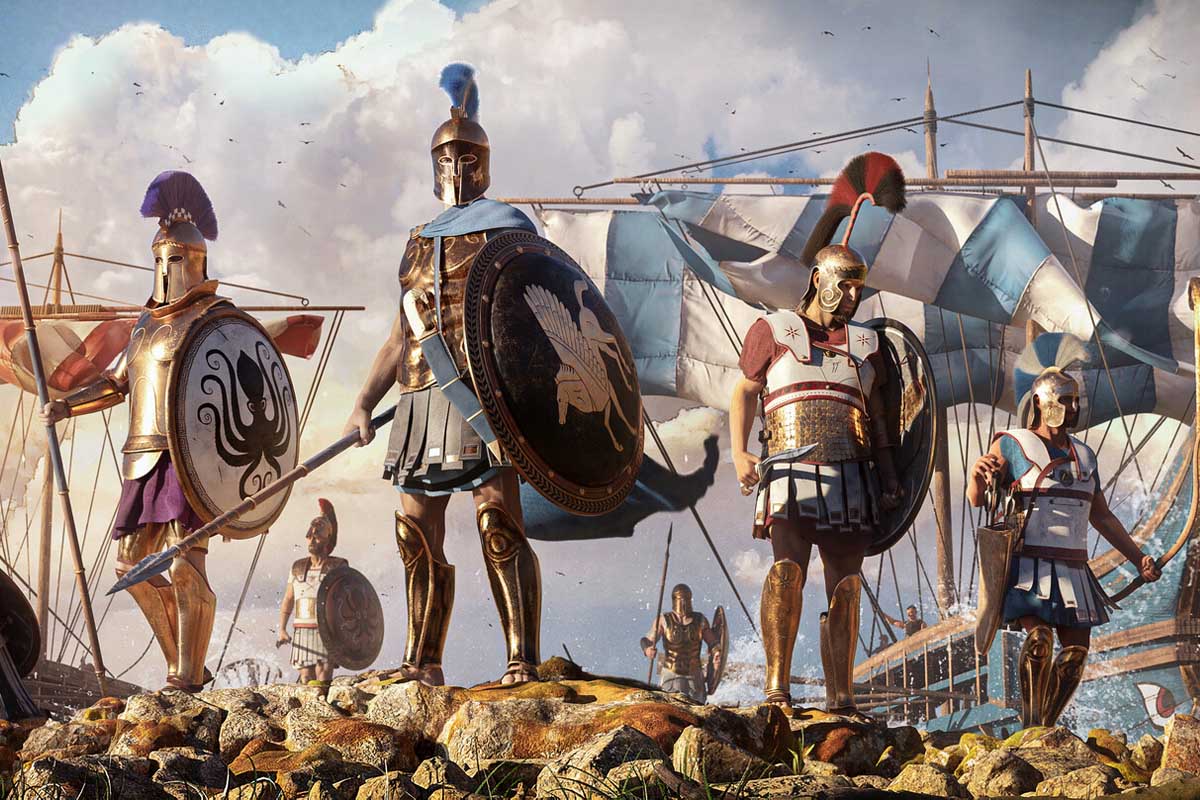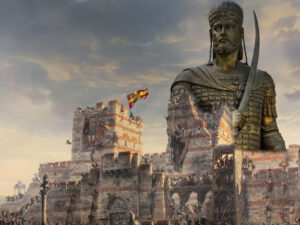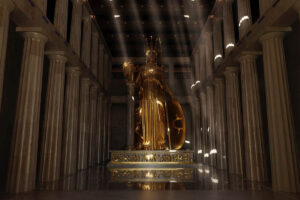Have you ever imagined Greeks fighting Sasquatches? A fleet in battle formations against giant whales? Towns made of bones? Fish people and Sun-loving cults coming in contact with the Hellenistic era explorers? Nearchus: A Journey into the Unknown.
You recently asked for Badass History and my Subscribers voted for a Hellenistic Era topic; I am here to deliver both with a wild exploration story. A journey of brave men who embarked to explore the unknown, and lived to tell the story. Such is our story today, the near-mythical and gruesome journey of Nearchus, Alexander’s admiral, who traversed the Great Southern Ocean on an expedition from India to the Persian Gulf.
Follow me on this journey while i narrate the unbelievable pain, anguish and glory of men who encountered monsoons, strange cults, beastly tribes and other sights that the Greeks could not have imagined possible.
In the waning days of Alexander the Great’s relentless campaigns, as the fires of conquest simmered in the embers of an empire stretched to its limits, a new odyssey beckoned. The Southern Ocean, vast and shrouded in mystery, called out to the bold and the brave.
Among those who answered this call was Nearchus, a trusted admiral and friend of Alexander, whose name would be etched into the annals of history as a daring explorer of uncharted waters.
The career of Nearchus (360-312 BC), who came from Crete, is inexorably tied with that of his friend and leader, Alexander the Great. Initially recruited by Philipp, he fought by the side of his friend and commander, Alexander, until the end.
His role as a close associate was revealed early when the leader granted him the role of satrap over the provinces of Lydia and Pamphylia in Asia Minor. Now, as they regrouped and met in India, they began preparations for the return to the West and Alexander again granted Nearchus the position of admiral of the fleet.
Alexander’s plan, after consolidating power in Western India and reaching the delta of the Indus, was to separate his army and send half with a fleet, led by Nearchus, to explore the Ocean find the best possible sea route.
Nearchus was tasked with an extraordinary mission: to navigate the treacherous waters from the mouth of the Indus River, across the vast expanse of the Southern Ocean, back to the familiar shores of Persia.
Alexander led personally the other half through the harsh deserts of Carmenia and Gedrosia; they would rendezvous at the mouths of the great Rivers Tiger and Euphrates.
Read more on Tanea.com.au
In crossing the desert, Alexander’s army took enormous casualties from hunger and thirst, but fought no human enemy. It is still not well understood why he chose that treacherous route through such a harsh desert, that had annihilated the armies of Semiramis and Cyrus in the past.
Some claimed that he was angry at his army (the Greek backbone at least) that had denied his wish to continue fighting in India. My personal take is that the reason was dual:
A. He was an incredibly gifted strategist and an explorer. He knew that in order to hold India he needed to discover more efficient routes to transport goods and armies.
B. His soul ached for exploration and glory; he knew that no army had managed to cross the desert of Gedrosia, but that meant no one had explored it either. He wanted to be the only one. And indeed, he was.
More than half the army perished in that crossing and this is where we see the legendary leadership skills and mental strength of Alexander; when some scouts found a few drops of water, they took it to the King. He thanked them and in front of the whole army spilled in on the ground saying: “If they don’t drink, I don’t drink either”. How can you not admire the strength of this man, even at his weakest?
Nearchus’ journey, on the other hand, commenced in 326 BCE; with a fleet of sturdy ships and a crew seasoned by battle and hardship, Nearchus set sail, venturing into waters that had seldom felt the keel of a Greek ship. The ocean was an enigmatic force, a domain of gods and monsters in the minds of the ancient sailors. The Southern Ocean, with its unpredictable monsoons and hidden perils, was a canvas of both dread and wonder. The size of the fleet must have been tremendous with wild accounts claiming it had anywhere from 150 to 800 vessels (or more), many as large as hundreds of tons. Nearchus engaged the services of Indian pilots who would serve as guides. Late in September, the fleet departed from the mouth of the Indus.
Due to unfavorable winds and dangerous monsoons, they camped near the mouth of the Indus and Arabius Rivers, building stone walls as fortification against hostile natives and subsisting off of briny water, mussels, oysters, and razor-fish. After 24 days, Nearchus continued on to the harbor of Morontobara (Manora Island just off the coast of modern Karachi, Pakistan) and sailed West.
Days turned into weeks as Nearchus and his men braved the wrath of Poseidon. Storms lashed their vessels, waves towered like the very Titans of myth, and the sun blazed mercilessly overhead, turning the ocean into a shimmering, unending desert. The nights brought no respite, only the haunting songs of the sea and the glimmer of strange constellations. He was a man possessed by vision, driven by the thirst for discovery and the mandate of his king. Arian says that after penetrating forty stadiums inland they found a water-hole, and after drawing water thence they returned back again. By the harbor there was a high island, and desert, and around it one could get oysters and all kinds of fish. Up to this the country of the Arabians extended; they were the last Indians settled in this direction; from here on the territory, of the Oreitans began.
The fleet encountered islands teeming with exotic flora and fauna, sights that stirred the imagination and filled the chronicles of their voyage with wonder. There were times when the sea seemed to mock their efforts, casting them into labyrinths of reefs and shoals. Supplies dwindled, and desperation gnawed at the edges of their resolve. But Nearchus, with a heart steeled by the spirit of adventure and the honor of his command, rallied his men, reminding them of the glory that awaited beyond the horizon.
The journey was taking much longer as they often had to disembark and scout (sometimes 50 miles) inland for water and supplies. Alexander, even though his army was undergoing extremely harsh conditions, always cared for the fleet and sent detachments to the shore to share their scarce food and water. At Morontobara, Leonnatus (one of Alexander’s Generals) had defeated the local Oreitans and deposited a food supply from which Nearchus’ fleet subsisted. The fleet scouts discovered and managed to refuel. Resupplied, Nearchus reached the Hingol River (in Makran, Balochistan) and destroyed the native population.
This is where they encountered the “Fish Eaters”, or Ichthyophagi, primitive people who lived on the Makran coast of the Arabian Sea. They had matted hair, no fire, no metal, no clothes, lived in huts made of whale bones, and ate raw seafood obtained by beachcombing.
In other stories, they are also described as being covered by hair, having nails like wild animals, and using only clubs as weapons. Sometimes they tried stopping the disembarkation of the Greeks on the beach and were met with arrow volleys and ballistae bombardment from the ships before the hoplites engaged them.
In one of those encounters, an actual battle took place. The dawn broke over a desolate coastline, the rising sun casting long shadows over the jagged rocks and a rocky desert that loomed ominously beyond the beach. As the fleet was closing on the shore, for disembarkation, this new and unexpected enemy emerged from the rocks —gigantic, fur-covered figures, guardians of this uncharted territory. These creatures, towering and muscular, let out deafening roars that echoed across the bay. With ancient, primitive weapons in hand, they charged down the slope towards the beach, their sheer size and ferocity enough to send chills through even the bravest of men.
As the Greek ships reached the shallow waters, the call to arms rang out. A volley of arrows arced through the sky, descending upon the charging Sasquatches like a deadly rain. Many found their marks, but the creatures’ thick hides absorbed much of the impact. Still, some fell, and the rest roared in fury, undeterred by the Greeks’ opening salvo. The artillery was put to work too; the massive war machines, positioned strategically on the larger vessels, launched their payloads—jagged rocks and flaming projectiles—into the midst of the enemy.
The hoplites, heavily armored and disciplined, leaped into the waist-deep surf, shields locked and spears at the ready. They pushed forward in a unified line, their movements synchronized and precise, the epitome of Greek martial prowess. The Sasquatches met them with ferocity. The first clash was thunderous, as the two forces collided. Spears pierced through fur and muscle, while massive, clawed hands swiped at shields, sending some men sprawling. Even though the initial onslaught was indeed ferocious, the creatures broke after a while, under the pressure of the Hoplite discipline and formation; I also assume the siege projectiles did have something to do with it. They escaped back into the rocky formations and the desert, never to be seen again.
The fleet continued; it took them 20 days to pass the coast along Makran, where they searched in vain for fresh water and again found the inhabitants hostile. At the River Kalami, Nearchus desecrated a place revered by a local sun-worshipping cult, violating taboos by setting foot on their sacred island of Astola. He apparently emerged unscathed from this incident, but the fleet was again running low on food, and had to hunt the strange local goats that smelled like fish, since they only ate fish, on the shore. He also noted that the local inhabitants paddled canoes, instead of rowing in the Greek fashion.
The expedition took on supplies at the town of Pasni in what is now Baluchistan, and as they continued westward, they found that the land was more fertile. Perhaps it was during this time that Nearchus observed sugar cane, which he described as a reed “that produce[s] honey, although there are no bees.” It was also in this region that Nearchus appears to have seen huge whales, reporting that he observed great towers of water blowing into the air. The sight must have been so bizarre that the fleet was called in battle formations, in order to fight the giant creatures. When the Greek fleet tried engaging the beasts, they just vanished or outmaneuvered them.
From there they sailed along the coast, reaching Persia at Cape Jask in the Kerman region. The voyagers glimpsed Cape Musandam, the tip of the Arabian Peninsula that serves as a dividing line between the Gulf of Oman and the Persian Gulf, but Nearchus resisted a suggestion from his principal lieutenant, Onesicritus, that they cross the Strait of Hormuz and explore the Arabian coast.
After many adventures, they arrived in Carmania in Southern Iran, meeting up with Alexander after the latter’s crossing of the Gedrosian desert. Here they noted that the area was well-cultivated with corn (grain), vines, and trees (apart from the olive tree cherished by Greeks).
During the voyage, Nearchus was reputedly the first Greek commander to visit Bahrain, which was called Tylos by the Greeks. His visit marked the start of Bahrain’s inclusion within the Hellenic world, which culminated in the worship of Zeus (as the Arab sun god, Shams) and Greek being spoken as the language of the upper classes. Bahrain even hosted Greek athletic contests. Nearchus recorded that Bahrain was a prosperous commercial island, stating: “That in the island of Tylos, situated in the Persian Gulf, are large plantations of cotton tree, from which are manufactured clothes called sindones, a very different degrees of value, some being costly, others less expensive. The use of these is not confined to India, but extends to Arabia.”
After reaching the Tigris River, Nearchus went as far as the Euphrates before turning back to rejoin Alexander at Susa, in early 324 BC. He and Onesicritus received a golden diadem for their actions. Nearchus married the daughter of Barsine and Mentor.
He then took the fleet up to Babylon, where he gave Alexander the Chaldeans’ prophetic warning not to enter the city, “because he would die, if he did”. Alexander scoffed at it and entered Babylon soon after. It is likely that in the ensuing power struggle between Alexander’s generals, Nearchus lost his satrapies in Asia Minor, and at this point he faded from the historical record. His accomplishments, immortalized by Arrian and Strabo, didn’t.
Nearchus’ voyage was more than a maritime expedition; it was an epic tale of human endurance and the insatiable quest for the unknown. His return was celebrated not merely as a navigational triumph but as a testament to the unbreakable will of explorers who dared to venture beyond the edge of the known world. Thanks to him, Middle East and Europe gained a new sea route to India, from whence they would import numerous valuable goods and—more important—ideas. The Southern Ocean, once a realm of mystery and fear, had been charted by the courage and skill of Nearchus and his men. Their journey carved a path through the annals of time, a saga of exploration that would inspire generations to come. In the grand tapestry of Alexander’s conquests, the voyage of Nearchus stands as a luminous thread, a tale of epic heroism amidst the boundless, enigmatic seas.












